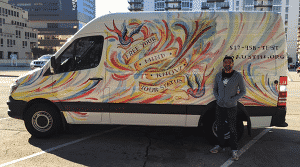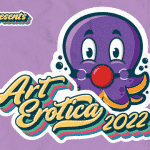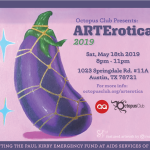“Free Your Mind, Know Your Status” is a call to action emended in the art wrapping the side of ASA’s testing van. The artwork was created by ASA staff member, Marcus Sanchez. In between ground-up community building at The Q and prepping for the upcoming sixteenth annual Art Erotica show, we sat down with Marcus to talk about the van art, community outreach, and how creativity plays a role in HIV/AIDS activism and support.
What was the concept behind the artwork?
Free Your Mind, Know Your Status came from the prevention team. We wanted something that really spoke to clients – when we took the van out to high risk neighborhoods, people had a lot of anxiety and stress over getting tested. It was the street outreach team that conceptualized the idea, and I stepped in with the art. I looked at other testing vans that had a lot of digital art, but I wanted something hand made with a DIY feel to reflect Austin’s unique art culture. But we also wanted something that spoke to all the communities we servewithin Austin; after all, the skyline looks different depending on which side of the bridge you are on. I decided to go with a sort of tattoo flash art design, something colorful and inviting that is easy for everyone to relate to. There are also no red ribbons or symbols that are overtly associated with HIV/AIDS, to reduce fear of stigmatization.
What was the creation process like? What medium was used to create the art?
We talked to Q clients and worked closely with focus groups concerning women and people of color. We wanted to know, “What would make you more inclined to step in the van and get tested?” I made the initial artwork mostly from watercolor, ink, and colored pencil, and it was really interesting to see how my art translated onto the van.
Do you feel like the art has a positive affect on people getting tested?
It has definitely opened the conversation up for a lot of new people. Sometimes when we are parked downtown at the clubs, people approach us thinking it’s a party bus. Even if they don’t get tested that day, it piques their curiously and starts a dialogue about sexual health and safer sex. It’s a conversation piece, especially since the slogan is written in English and Spanish. Our goal is always communication and outreach with the community, and it is helping us do just that.
Do you believe there is a place for art in the work ASA does?
Absolutely! At The Q, for example, we have rotating art from community. It brings people to the space and reaches them in a relatable way.
Do you have any other artistically inclined projects in mind for ASA programs?
Right now at The Q, we’ve created a SXSW campaign where we are partnering with the City of Austin and other nonprofits to create bus ads and wrist bands to get the word out in the community. I’m also participating in Art Erotica for the Paul Kirby Emergency Fund. Specifically, I’m working with the Penis Project: I make plaster molds of penises and give to artists to decorate however they like. At the show, they will all be auctioned off. There’s a Vagina Project, too!




